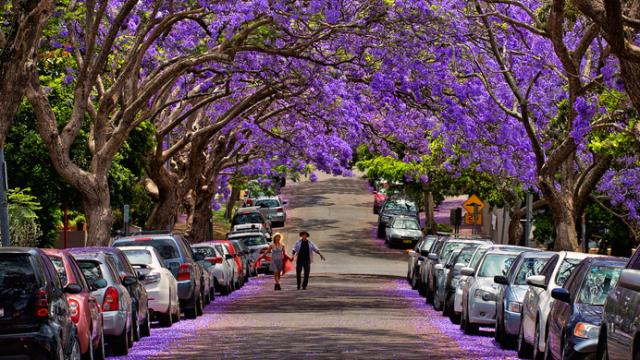We know we should walk more, we hear it all the time. Don’t sit too much, stand up every once in a while, stroll around a bit, better yet, take all your meetings on foot. But not all walks are created equal. It turns out where we walk matters, and a natural setting can not only provide physical benefits but also do wonders for our mental health.
The physiological benefits of walking have long been touted, as have other intangible benefits of perambulation like idea generation. But a smattering of studies in the last few weeks have pointed towards another interesting side-effect of walking: It can boost our feelings of well-being, not just through the act of walking as exercise, but because of the environment in which we choose to walk.
The New York Times’ Well blog explores two studies in this area by Stanford researchers. The first study, led by Gregory Bratman and published in Landscape and Urban Planning, sent 60 volunteers on 50-minute walks, some in a leafy section of campus, others among a busy freeway. Subjects who got a heavy dose of nature with their walk were happier and more focused afterwards than the freeway walkers.
Well, of course, you might say, who wants to walk along a freeway? But quantifying the differences was important — what about walking in nature was better for the brain, and why? A second study by the same team published in the Proceedings of the National Academy of Sciences tried to figure that out. Specifically, they looked at the effect of nature walks on the subgenual prefrontal cortex, the part of the brain that controls “brooding” or “rumination” — you know, when you’re sitting and stewing over the same negative thoughts over and over.
After noting normal brain activity in the subgenual prefrontal cortex, they sent 38 volunteers out on a 90-minute walk in the same two places: verdant Stanford campus corridor or busy Palo Alto freeway-adjacent footpath. From the NYT story:
As might have been expected, walking along the highway had not soothed people’s minds. Blood flow to their subgenual prefrontal cortex was still high and their broodiness scores were unchanged.
But the volunteers who had strolled along the quiet, tree-lined paths showed slight but meaningful improvements in their mental health, according to their scores on the questionnaire. They were not dwelling on the negative aspects of their lives as much as they had been before the walk.
The study is important because our massive re-urbanisation of cities has proved to have seriously detrimental effects on our mental health — so maybe a short walk in nature can reverse the damage. But surely you don’t need to flee for the hinterlands when you feel a rumination coming on? What if you can’t get to a park or the Stanford campus? Can you get the same boost from a street? Or more specifically: Exactly how many trees does one need to feel good?
A New Yorker article examined this very topic through a study in the journal Scientific Reports authored by University of Chicago psychologist Marc Berman. The study looked at the health of 94,000 Torontonians when compared to two datasets: accessibility to nearby green space, as determined by satellite imagery, and proximity to 530,000 trees, plotted by city inventory.
After controlling for income, education, and age, Berman and his colleagues showed that an additional ten trees on a given block corresponded to a one-per-cent increase in how healthy nearby residents felt. “To get an equivalent increase with money, you’d have to give each household in that neighbourhood ten thousand dollars — or make people seven years younger,” Berman told me.
Seven years younger! SOLD.
The mandate here is pretty clear for urban planners who are trying to design more greenspace into cities to make residents healthier. Now in addition to the physical benefits provided by investing in things like jogging paths and walking trails, there’s a proven mental benefit as well. Just providing better access to these nature opportunities, especially in low-income areas which are park-deprived, could dramatically improve people’s moods.
But these studies also prove that we don’t necessarily need to escape into some urban wilderness for positive vibes. Sometimes, a few more trees planted on a block makes all the difference. The key is knowing which of these streets meets that tree-to-block ratio.
Last year we reported on a Yahoo algorithm that would help walkers find not just the most direct route, but the most scenic route between two points. The new Walkonomics app does exactly that, although only for a handful of cities at the moment.
When you search for a destination, the app will offer you a route with the shortest distance, but also an alternate one that’s deemed most beautiful. The routes are calculated using the same kind of data collected for the Toronto study, using information like tree inventories, street width, and park data. Using this app you could plot a 25-minute mental health stroll in the middle of a city that increases your exposure to nature for maximum mood-boosting.
I definitely find myself detouring down certain streets here in LA for all sorts of feel-good reasons — trees for sure, but also better footpaths or weirder architecture. These studies proved that people are happier walking past trees than freeways, but what about all the urban landscapes in-between — skyscrapers vs. strip malls; Victorian vs. modern houses. Maybe soon an app will allow me to set my personal walking environment preferences, guiding me through the city on customised journeys that will increase my happiness along the way. Trees are universally smile-inducing, but I’d argue that my mood would be equally boosted by discovering a really good taco truck.
Picture: PomInOz / Shutterstock.com
